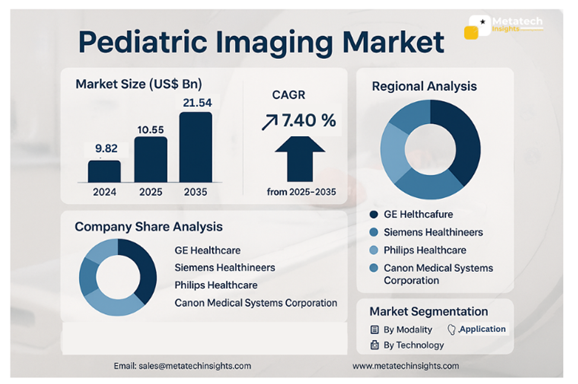Global Pediatric Imaging Market to Hit USD 21.54 Bn by 2035 | CAGR 7.4%
27 Aug 2025 | Report ID: MI3502 | Industry: Healthcare | Pages: 219 | Forecast Year: 2025-2035

Read more about this report- Global Pediatric Imaging Market to Hit USD 21.54 Bn by 2035 | CAGR 7.4%
- Metatech Infographics: Smart Data, Market Segments & Future Trends at a Glance.
- The Pediatric Imaging Market is valued at USD 9.82 Billion in 2024. The Pediatric Imaging Market will achieve USD 21.54 billion by 2035 through a projected 7.4% CAGR from 2025 to 2035.
- The increased demand to screen infants and children earlier in cases of congenital disorders and other chronic diseases and conditions is the primary market driver, whereas the possible long-term health consequences linked to the radiation exposure of the child subject are the most important limitations in healthcare. A potential new area is the combination of AI and low-dose imaging technologies with a view to introducing safer and faster but more accurate diagnostics in the interests of children.
- The paediatric imaging market is categorised in terms of product types that include ultrasound, MRI, CT, X-rays, and nuclear imaging, and the end-use MOCs include hospitals, special paediatric centres, and diagnostic imaging clinics. Ultrasound is the dominant modality in this market, as it is radiation-free and has increasing utilisation in postnatal and abdominal imaging, especially where safety is important in the most delicate cases of children.
- The imaging applications of paediatrics include cardiology, oncology, neurology, orthopaedics, and gastroenterology. Neurological imaging is becoming paramount in children due to enhanced MRI scanning techniques and AI-guided brain scans that have the potential to identify the signs of developmental disorders and epilepsy early on, which changes the clinical outcome through early interventions.
- The context of an increasing burden of diseases in children, rising health spending levels, and better imaging received infrastructures favours global uptake. The NHS has implemented centrally located teleradiology hubs and AI pilot programmes in the United Kingdom to increase the intake capacity of paediatric radiology to reduce delayed paediatric diagnoses and alleviate backlogs of patients.
- The paediatric imaging industry is maintained by five geographic regions that have five regions: North America, Europe, Asia-Pacific, Latin America, and the Middle East and Africa. In India, concern over the increasing healthcare burden on children has resulted in the growing number of paediatric healthcare initiatives via national health programmes and the involvement of an increased number of participants, especially the private sector, which is boosting the demand for paediatric imaging services, with key emphasis being made on portable ultrasound and point-of-care solutions across those areas that are considered underserved.
- Other key players in the paediatric imaging market include GE Healthcare, Siemens Healthineers, Philips Healthcare, Canon Medical Systems, and Mindray. These companies impact the development of the market by bringing such innovations as paediatric-optimised imaging platforms, AI-amplified diagnostic tools, and remote diagnostics opportunities that expand the accuracy with minimal risks of exposure to children.
Maximize your value and knowledge with our 5 Reports-in-1 Bundle - over 40% off!
Our analysts are ready to help you immediately.
